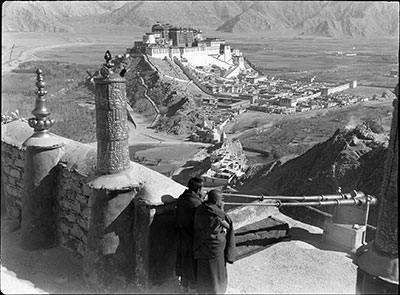
1998.131.305.1 (Film negative)


1998.131.305.1 (Film negative)

Frederick Spencer Chapman
Frederick Spencer Chapman
October 2nd 1936
Lhasa > Potala (from Chakpori)
1998.131.305.1
81 x 111 mm
Negative film nitrate
Donated 1994
Faith Spencer Chapman
British Diplomatic Mission to Lhasa 1936-37
Frederick Spencer Chapman
C.6.10 [view film roll]
SC.T.2.305
In Negative - The number '10' is printed on the negative on the lower left hand edge [MS 7/4/2005]
Technical Information - This image was taken with a quarter plate Zeiss Nixe film or film pack camera as the negative is quarter-plate sized. See Chapman Lhasa The Holy City [London: Chatto & Windus, 1938] for a description of the still and cine cameras that Chapman used as Mission photographer [MS 25/2/2005]
Manual Catalogues - Caption in Chapman's hand-written list of negatives made whilst on the Mission to Lhasa, 1936-7 [See PRM Manuscripts Collection]: 'Potala from Hospital Hill [Chakpori]'; PRM Manuscripts Collection: ‘List of Tibetan Prints and Negatives’ - Book 2: ‘1/4 - Potala in winter’ [MS 18/03/2006]
Research publication - Clare Harris and Tsering Shakya (eds.) 'Seeing Lhasa: British Depictions of the Tibetan Capital 1936-1947' Chicago: Serindia Publications, 2003, pp. 30-31.
Exhibition - This image appeared in the 2003 Temporary Exhibition at the Pitt Rivers "Seeing Lhasa: British Depictions of the Tibetan Capital 1936-1947"
Other Information - Related Images: Images prefixed with 'C.6' comprise a group of negatives containing images of Trimon and 4th/5th rank officials, Amir Khan and staff, Ringang, lunch party, Yellow Hat Monks, Potala views, Norbhu Lingka stables. They all seem to have been taken between October 1st - 3rd 1936 [MS 18/03/2006]
Other Information - Setting: This photograph was taken from Chakpori hill, where the Medical College was based. Chapman describes the effect of seeing the Potala from this vantage point in his book Lhasa the Holy City [London: Chatto & Windus, 1938; reprint, London: Readers Union Ltd., 1940]: "Seen from the top of the Iron Hill it is as near perfection as anything in this world can be. Buildings in other countries may challenge comparison with the Potala; but to my mind no edifice, so perfect in itself, is placed in such incomparable surroundings. // One looks down on to the three chortens of the Western Gate, and on each side of it a sea of tree-tops, with the tenuous green of the willows set off by the darker poplars. Between the trees are pools of water reflecting the blue sky, or level expanses of grass. A mile away to the east, appearing through the greenery as a broken white line, is the city of Lhasa, with the golden Cathedral roofs catching the sun and leading up to the larger mass of gold on the Potala roof" [ibid., p.172] [MS 4/4/2005]
Other Information - Historical Background: In the foreground, monks sounding trumpets from the roof of the Tibetan Medical College at Chakpori. The Chakpori (Iron Hill) is considered to be one of Tibet’s four most sacred mountains and hence the 5th Dalai Lama constructed the medical college there in the 17th century. The college combined the study of medicine and Buddhism. The building later provided an ideal vantage point from which to photograph the Potala Palace and the village of Sho [CH 2003]
Other Information - Cultural Background: The radung are telescopic copper horns (copper is considered an auspicious metal) always played in pairs and used especially to announce ceremonies. [ Marina de Alarcón ZF 1995.1]
Other Information - Cultural Background: The radung or horns can be reduced in size by pushing them in on themselves like a telescope. Gyaltsen or Victory banners made of brass or copper can be seen in the left of the image symbolizing the victory of Buddhism [TS 7/2/2005]
For Citation use:
The Tibet Album.
"Monks blowing radung , Potala in distance"
05 Dec. 2006. The Pitt Rivers Museum.
<http://tibet.prm.ox.ac.uk/photo_1998.131.305.1.html>.
For more information about photographic usage or to order prints, please visit the The Pitt Rivers Museum.
© The Pitt Rivers Museum